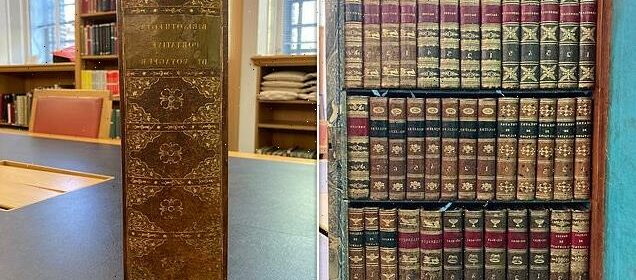Cambridge University buys 19th century 'Victorian Kindle'

Cambridge University buys 19th century ‘Victorian Kindle’ the size of a shoebox containing 38 tiny books for undisclosed sum
- Travelling library has been added to university collection and has French books
- Has been described as a ‘Victorian Kindle’ by rare book specialist Liam Sims
- The book was sold to the University library for an undisclosed sum
- It will nestle among the other one million rare books in the library’s collection
Cambridge University has bought a 19th century ‘Victorian Kindle’ the size of a shoebox containing 38 tiny books for an undisclosed sum.
The ‘travelling library’ has been added to a university collection and contains 9cm-long (3.5in) French books.
It has been described as a ‘Victorian Kindle’ by rare book specialist Liam Sims, of the Cambridge University Library.
The item looks like a book on the outside and was made in the early 1800s.
This particular travelling library contains tiny novels by authors such as Voltaire and Racine, which were printed between 1802 and 1818.
It was described by Mr Sims as a ‘surprise when you open it up.’
The ‘travelling library’ has been added to a university collection and contains 9cm-long (3.5in) French books
Historically, people took long horse-drawn coach journeys and needed some form of entertainment.
Travelling libraries grew in popularity as they helped people to while away the hours.
This travelling library would have been easy to take on coach travels as it is portable.
It also does not take up much space which is why Mr Sims described it as a ’19th Century Kindle.’
He explained that the University decided to purchase the travelling library as they thought it would be something fun to share with people.
They also thought that it would be a good item for them to add to their shelves.
It was not disclosed how much the university paid for the travelling library.
The travelling library is now nestled amongst the other rare books on the shelves- a total of one million.
Source: Read Full Article
